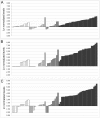Expression of androgen receptor splice variants in prostate cancer bone metastases is associated with castration-resistance and short survival
- PMID: 21552559
- PMCID: PMC3084247
- DOI: 10.1371/journal.pone.0019059
Expression of androgen receptor splice variants in prostate cancer bone metastases is associated with castration-resistance and short survival
Abstract
Background: Constitutively active androgen receptor variants (AR-V) lacking the ligand binding domain (LBD) may promote the development of castration-resistant prostate cancer (CRPC). The expression of AR-Vs in the clinically most important metastatic site, the bone, has, however, not been well documented. Our aim was therefore to compare levels of AR-Vs in hormone-naive (HN) and CRPC bone metastases in comparison to primary PC and non-malignant prostate tissue, as well as in relation to AR protein expression, whole-genome transcription profiles and patient survival.
Methodology/principal findings: Hormone-naïve (n = 10) and CRPC bone metastases samples (n = 30) were obtained from 40 patients at metastasis surgery. Non-malignant and malignant prostate samples were acquired from 13 prostatectomized men. Levels of full length AR (ARfl) and AR-Vs termed AR-V1, AR-V7, and AR-V567es mRNA were measured with RT-PCR and whole-genome transcription profiles with an Illumina Beadchip array. Protein levels were examined by Western blotting and immunohistochemistry. Transcripts for ARfl, AR-V1, and AR-V7 were detected in most primary tumors and metastases, and levels were significantly increased in CRPC bone metastases. The AR-V567es transcript was detected in 23% of the CRPC bone metastases only. A sub-group of CRPC bone metastases expressed LBD-truncated AR proteins at levels comparable to the ARfl. Detectable AR-V567es and/or AR-V7 mRNA in the upper quartile, seen in 1/3 of all CRPC bone metastases, was associated with a high nuclear AR immunostaining score, disturbed cell cycle regulation and short survival.
Conclusions/significance: Expression of AR-Vs is increased in CRPC compared to HN bone metastases and associated with a particularly poor prognosis. Further studies are needed to test if patients expressing such AR-Vs in their bone metastases benefit more from drugs acting on or down-stream of these AR-Vs than from therapies inhibiting androgen synthesis.
Conflict of interest statement
Figures




References
-
- Chen CD, Welsbie DS, Tran C, Baek SH, Chen R, et al. Molecular determinants of resistance to antiandrogen therapy. Nat Med. 2004;10:33–39. - PubMed
-
- Crnalic S, Hornberg E, Wikstrom P, Lerner UH, Tieva A, et al. Nuclear androgen receptor staining in bone metastases is related to a poor outcome in prostate cancer patients. Endocr Relat Cancer. 2010;17:885–895. - PubMed
-
- Stanbrough M, Bubley GJ, Ross K, Golub TR, Rubin MA, et al. Increased expression of genes converting adrenal androgens to testosterone in androgen-independent prostate cancer. Cancer Res. 2006;66:2815–2825. - PubMed
Publication types
MeSH terms
Substances
LinkOut - more resources
Full Text Sources
Other Literature Sources
Medical
Molecular Biology Databases
Research Materials

